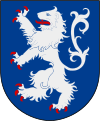Halland, Sweden
| Halland | ||
|---|---|---|
|
||
 |
||
| Country | Sweden | |
| Land | Götaland | |
| County |
Halland County Västra Götaland County Skåne County |
|
| Area | ||
| • Total | 4,796 km2 (1,852 sq mi) | |
| Population (2009) | ||
| • Total | 303,895 | |
| • Density | 63/km2 (160/sq mi) | |
| Ethnicity | ||
| • Language | Swedish | |
| • Dialect |
Halländska Götamål |
|
| Culture | ||
| • Flower | Broom | |
| • Animal | Salmon | |
| • Bird | Peregrine falcon | |
| • Fish | Salmonidae | |
| Time zone | CET (UTC+1) | |
| • Summer (DST) | CEST (UTC+2) | |
| Area codes | 0300 0340–0346 0430 |
|
![]() Halland is one of the traditional provinces of Sweden (landskap in Swedish), on the western coast of Sweden. It borders Västergötland, Småland, Scania and the sea of Kattegat. Until 1645 and the Second Treaty of Brömsebro, it was part of the Kingdom of Denmark.
Halland is one of the traditional provinces of Sweden (landskap in Swedish), on the western coast of Sweden. It borders Västergötland, Småland, Scania and the sea of Kattegat. Until 1645 and the Second Treaty of Brömsebro, it was part of the Kingdom of Denmark.
The provinces of Sweden serve no administrative function. Instead, that function is served by the Counties of Sweden. However, the province of Halland is almost coextensive with the administrative Halland County, though parts of the province belong to Västra Götaland County and Skåne County, while the county also includes parts of Småland and Västergötland.
As of December 31, 2009, Halland had a population of 303,895. Of these, 287,668 lived in Halland County; 13,980 lived in Västra Götaland County; and 2,247 lived in Skåne County.
During the Danish era until 1658, the province had no coat of arms and no seal. In Sweden, however, every province had been represented by heraldic arms since 1560. When Charles X Gustav of Sweden suddenly died in 1660 a coat of arms had to be created for the newly acquired province. Each province was to be represented by its arms at the royal funeral. There are several theories about the choice of a lion. Bengt Algotsson, duke of Halland and Finland in the 14th century, used a lion in his personal arms. Blazon: Azure, a Lion rampant Argent langued, armed and dente Gules.
...
Wikipedia

